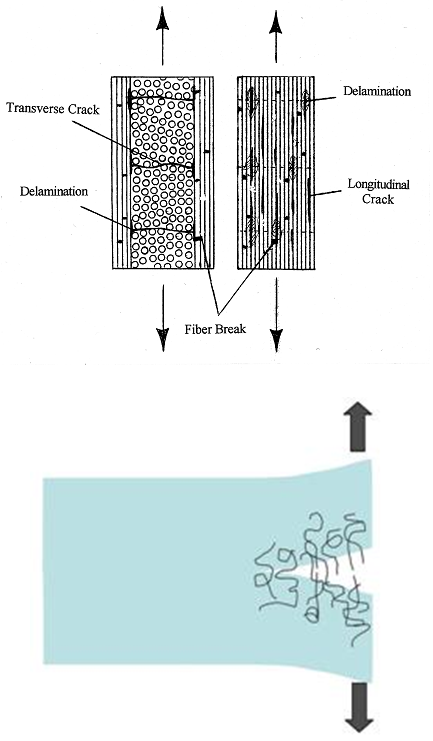Research / Micro/NanomechanicsFailure of Composite Materials
Damage mechanics of composite materials is concerned with the various damage mechanisms, their evolution under thermomechanical loading, and their effect on the elastic, failure, and fatigue behavior of a composite structure.
 Epoxy materials span a wide range of applications, from sporting equipment to structural components in the automotive and aerospace industries. It has been known for two decades that dispersing a second elastomer (or rubber) phase into an epoxy matrix can result in dramatic fracture toughness improvements. However, the ductility imparted by the rubbery phase typically results in a concurrent decrease in the materials modulus, or stiffness. Carbon nanotubes with strengths on the order of 1 TPa are seen as very promising candidates as nanofillers for simultaneously improving both the stiffness and toughness of rubber-toughened epoxy materials. As such, various systems involving the efficient dispersion of both rubber particles and carbon nanotubes are being tested in order to obtain the optimal balance between toughness and stiffness. In nanoreinforced polymers, nanotubes are typically curved and entangled in situ. This is in stark contrast to traditional composites (both short and continuous fiber) in which fibers are straight and often aligned. This nanoparticle morphology will greatly impact thermomechanical properties of these systems. The goal of research is to take into account the phenomenon of nanotube curvature and entanglement and to examine its effect on the critical properties of toughness and strength in nanocomposites. The results will be useful for the design of nanoreinforced polymers which have optimized thermomechanical properties.
Epoxy materials span a wide range of applications, from sporting equipment to structural components in the automotive and aerospace industries. It has been known for two decades that dispersing a second elastomer (or rubber) phase into an epoxy matrix can result in dramatic fracture toughness improvements. However, the ductility imparted by the rubbery phase typically results in a concurrent decrease in the materials modulus, or stiffness. Carbon nanotubes with strengths on the order of 1 TPa are seen as very promising candidates as nanofillers for simultaneously improving both the stiffness and toughness of rubber-toughened epoxy materials. As such, various systems involving the efficient dispersion of both rubber particles and carbon nanotubes are being tested in order to obtain the optimal balance between toughness and stiffness. In nanoreinforced polymers, nanotubes are typically curved and entangled in situ. This is in stark contrast to traditional composites (both short and continuous fiber) in which fibers are straight and often aligned. This nanoparticle morphology will greatly impact thermomechanical properties of these systems. The goal of research is to take into account the phenomenon of nanotube curvature and entanglement and to examine its effect on the critical properties of toughness and strength in nanocomposites. The results will be useful for the design of nanoreinforced polymers which have optimized thermomechanical properties.

